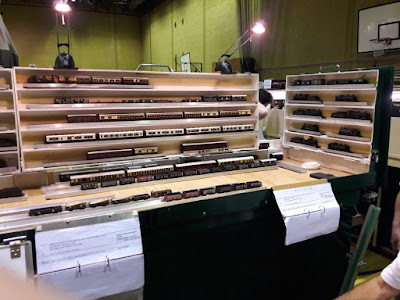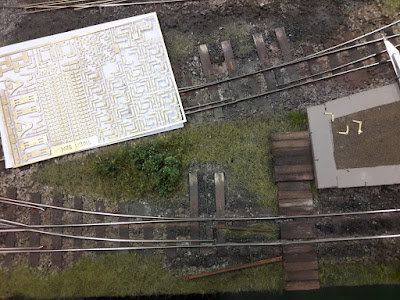Continue with scenery edge remedials.
Discuss backscene construction.
The last work session of 2018!
Geoff had been having a private running session and the stock was still on the layout, so we played trains for a while. It also gave us a chance to check over the track around the point rodding work and give the rails a good clean. Laurence was happy to see that his new cassettes were working ok.
Back to work, Stephen and Geoff addressed trimming-off the excess scenery extension strip. If edge of the baseboard frames were in anyway distorted, when the backscene is bolted to it, it could affect things adversely. It was therefore decided to level the baseboards first, which was easily achieved by adjusting the nuts and studding on the legs in conjunction with a long spirit level. A piece of wood was then notched to allow the line of the baseboard to be projected above the extended scenery and mark it at intervals. The marks were joined up, the line visually checked, and the excess removed with an oscillating saw.
The resulting edge was sanded and plaster mixed with PVA applied to eliminate some ridges. It will be sanded and painted ready for the area to be re-flocked in due course.
We then sat down and discussed the manufacture of the backscene. Material - 6mm MDF won the vote unanimously. The next decision to make was the height as we have a tall tree at one end, a much lower brick wall at the other and one operator a bit smaller than the other two. We soon decided on a shaped backscene. Assuming we used bolts into tee nuts in the main baseboard timbers, the tree end would be approx. 550mm high, and the wall end approx. 335mm high. For the ends, a high panel would be required across the fiddleyard interface and a low panel from the corner to the front edge of the wall. Along the wall sections, the projection of the capping details would be accommodated by using spacers in the bolt fixings rather than cutting the overhangs off. We didn't decide whether to have a panel across the front of the fiddleyard, but we'll decide in due course.
We then debated how many sections it should be made in - i.e. whether to coincide with board joints or go for a minimum of joints. At just over 3m, two pieces would be 1.5m - not unmanageable or a problem to transport. A two-piece backscene would have the joint behind the generator building at a point where a rib within the glass fibre hill could be used for additional support. We'll make a decision when we have the board in our hands. A quickly prepared cutting schedule showed that both options could be accommodated with a 2.44 x 1.22m sheet pre-cut into three strips by the supplier.
We wish all our followers a very MERRY CHRISTMAS and a HAPPY NEW YEAR!






















































